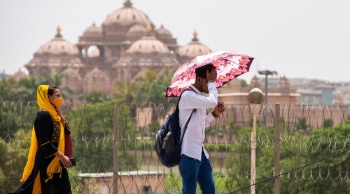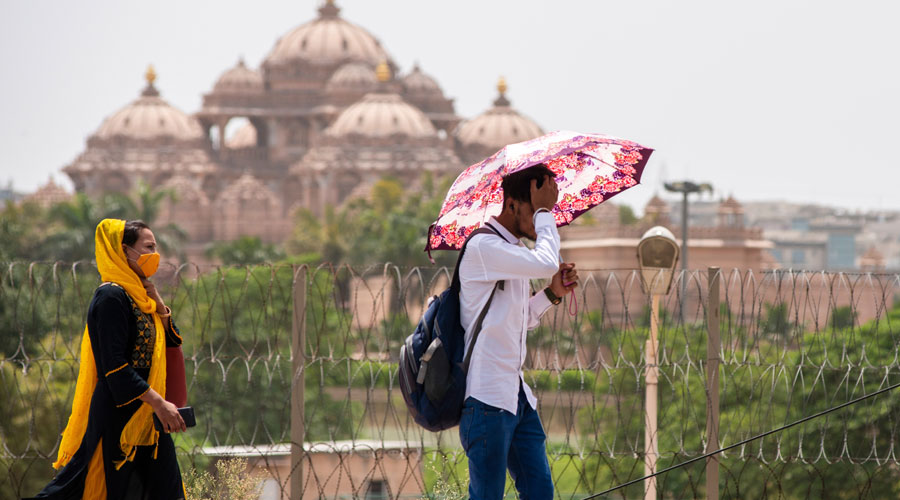
.png) Aarti
Aarti

With a hotter than normal summer expected this year, mitigation measures are important to manage heatwaves.
On this April 16, around 13 persons in Navi Mumbai lost their lives from a heatstroke. As an immediate measure, Maharashtra Government has banned all open-air public meetings and rallies between 12 noon and 5 PM.
Looking beyond several debates that the above incident has generated, the writing on the wall indicates that a hotter than normal summer is expected in 2023. On an average 5-6 heatwaves occur over north India every year. Notably, a recent study has found that the annual average extreme weather events in the Indian subcontinent has been rising during the last few decades. In particular, the mortality rate for heatwaves has increased by 62.2 percent in the past 20 years.
Let’s for a moment have a look at the official weather outlook. On 28 February this year, the India Meteorological Department (IMD) issued a Press Release on the seasonal outlook for hot weather season (March to May) 2023 and Monthly Outlook for March 2023 for the rainfall and temperature.
The main takeaways are: (i) during the upcoming hot weather season (March to May (MAM)), above normal maximum temperatures are likely over most parts of northeast India, east and central India and some parts of northwest India; (ii) normal to below normal maximum temperatures are most likely over remaining parts of the country;(iii) during the season (MAM), above normal minimum temperatures are very likely over most parts of the country except south peninsular India where normal to below normal minimum temperatures are likely;(iv) enhanced probability of occurrence of Heatwave during March to May season is likely over many regions of Central and adjoining Northwest India. A low probability for occurrence of heatwave over Central India is likely during March 2023.
What is a heat wave? Simply put, it is a period of abnormally high temperatures, more than the normal maximum temperature that occurs during the hot weather season. An important factor attributed to heat waves, according to various studies, is that climate change caused by the burning of fossil fuels.
This global phenomenon is said to be making extreme and unprecedented heat events. While Climate Scientists at the University of California at Los Angeles maintain that heat waves are probably the most underestimated type of potential disaster because they routinely kill a lot of people, there are other researchers who seem to suggest with climate change the world is seeing shifting wind patterns and weather systems in ways that makes heat waves more intense, persistent and widespread.
The Arctic region, reportedly warming three to four times faster than the globe as a whole, has been witnessing swings in the North Atlantic jet stream, which in turn leads to extreme weather events like heat waves and floods. With a strong change in ocean temperatures, warmer oceans have been causing heat domes which trap heat over large geographical areas. The extreme heat is also raising the risk of wildfires.
So, how to be prepared?
The IMD uses colour codes in weather warnings to highlight the severity of the weather phenomena expected and at the same time forewarn the relevant authorities on the impact of the weather expected. Green alert means no action is needed. Yellow alert means “watch and stay updated” where moderate temperature will prevail and heat is tolerable for general public but moderate health concern for vulnerable people like infants, elderly, people with chronic diseases.
IMD’s advisory is that one has to avoid heat exposure, wear lightweight, light coloured, loose, cotton clothes and keep the head covered by using a cloth, hat or umbrella. Orange alert means “Be prepared”. Orange alert areas will witness high temperature, increased likelihood of heat illness symptoms in people who are either exposed to sun for a prolonged period or doing heavy work. High health concern for vulnerable people like infants, elderly, people with chronic diseases.
There is a need to keep oneself hydrated. Apart from drinking sufficient water -- even if one is not thirsty -- homemade drinks like lassi, rice water, lemon water, buttermilk, etc. have been recommended. Red alerts mean “Take action” – these are warnings for heavy rainfall and its related impacts.
The IMD usually issues (alerts) heat wave warning for 5 days in advance. Following IMDs recent heatwave alerts, all educational institutions in West Bengal have been ordered to remain closed for the next week. In Delhi, schools have been directed not to conduct afternoon assemblies due to high temperature. In Patna, all schools have been ordered to close by 10:45 AM. Schools in Tripura have been shut for a week due to the prevailing heatwave conditions. With the mercury crossing 37°C, schools in Meghalaya’s West Garo Hills district have been directed to be closed for three days.
Heatwaves impact human health and animals adversely. As temperatures rise, the body may not be able to shed excess heat well enough to remain healthy. Although all age groups may not suffer equally, the cause for concern is that the stress induced due to the heat waves increases respiration and mortality, reduces fertility, modifies animal behaviour, and suppresses the immune and endocrine system, thereby increasing animal susceptibility to some diseases. It can cause heat cramps -- swelling and fainting generally accompanied by fever below 39°C. Heat exhaustion can cause fatigue, weakness, dizziness, headache, nausea, vomiting, muscle cramps and sweating. Heat stoke can cause body temperatures to rise above 40°C leading to seizures or coma.
Researchers use wet bulb reading, a measurement which combines air temperature and relative humidity and gauges heat stress on the human body. A wet bulb reading of 35 °C is said to be the threshold beyond which humans cannot survive.
A World Bank report published last November has warned that India could become one of the first countries in the world where this threshold would be reached.
As per a WHO advisory, when the temperature rises above 35 °C, in order to prevent heat-related illness, it would be necessary to follow simple steps like restricting going outside during the hottest time of the day and also avoiding strenuous physical activity. During heat waves, it is required to keep the body cool by wearing light, loose-fitting clothes of natural materials, besides drinking fluids like water or fruit juices to keep the body hydrated and avoiding alcohol, too much caffeine, sugar including foods that are high in protein.
The living place ought to be kept cool by opening all the windows at night/early morning when the outside temperature is lower. Apart from switching off all artificial lighting and unwanted electrical devices, during the day, the windows facing the sun ought to be kept closed. Hanging wet towels can help cool down the room air. Doors and windows of airconditioned rooms need to be kept closed. Special care should be taken for infants or adults over the age of 60 or who have chronic health conditions.
In terms of mitigating measures, in handling heatwaves, we have the success story of Ahmedabad which experienced a devastating heatwave in May 2010 when temperatures surpassed 48°C. It left around 800 people dead. Reportedly bats and birds dropped dead from the trees. Local authorities assisted by experts developed the country's first heat action plan. Laudably enough, since its launch in 2013 an estimated 1,190 deaths have been avoided each year. Through the National Disaster Management Authority, specific heat action plans have since been implemented across 23 states and more than 100 cities and districts. A low cost but effective component of the heat plan is the "cool roof" initiative which uses coatings/materials that reflect sunlight and absorb less heat.
Even as heat wave is one of the severe weather phenomena, during summers there are reports of electrical fires which can be directly linked to the rise in temperature. Electric appliances like fans, coolers, air-conditioners, etc., when used continuously can lead to overheating, resulting in short circuits and sparking, thereby causing fires. Vehicle fires also go up during extreme heat. Small preventive measures like regular servicing of cars and electrical devices coupled with fire audits and adhering to various advisories issued by the authorities merit consideration.